This was published 8 months ago
135 years of secrets: Nintendo is more than a video game company
The gaming giant’s first museum, opening in Kyoto where the company was founded more than 130 years ago, celebrates its singular brand of innovative entertainment.
By Tim Biggs
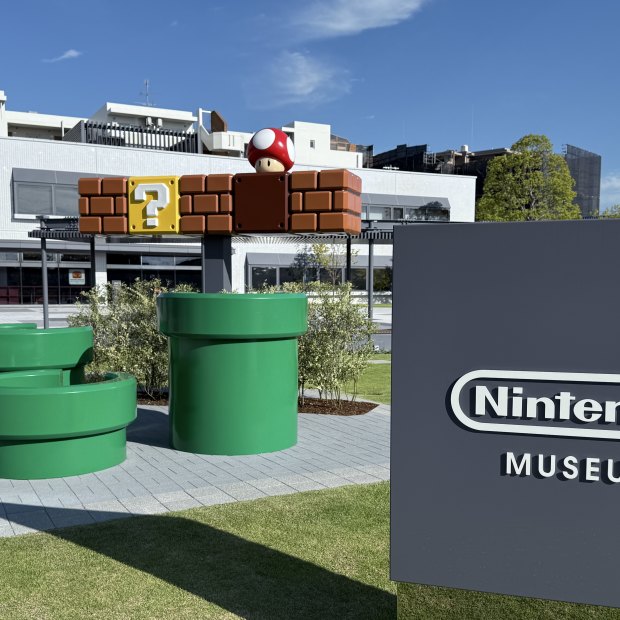
The Nintendo Museum, opening next month, is only a few train stops away from the company’s global headquarters in Kyoto Japan.Credit: Tim Biggs
Long before Donkey Kong, Super Mario and Pokémon were household names, Nintendo was founded as a playing card business in 1889. Now, 135 years later, as the Japanese entertainment giant looks to leverage its significant gaming properties to expand into wider fields like movies and theme parks, it is opening its first-ever museum in its home of Kyoto.
It’s an attraction that’s both unlike anything you’d ordinarily expect from a museum and exactly what you’d expect from Nintendo. Innovative technology powers a series of hands-on experiential exhibitions that celebrate products from the company’s long history, as well as a nostalgia-soaked (and extensive) collection of consoles, games, toys and rare items.
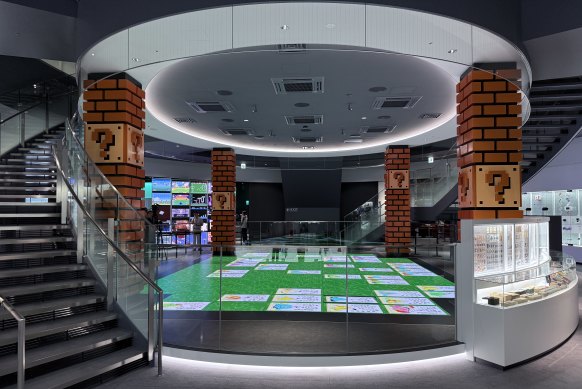
The lower level of the museum is filled with brand new interactive games and exhibits, celebrating products from Nintendo’s past.Credit: Tim Biggs
Even the cafe, called Hatena (meaning question, a reference to the famous Mario blocks), has diners using a web app to construct burgers from various ingredients, so they don’t know exactly what the combination will be like until they unwrap it.
And the ticketing system is gamified, too, in a way that’s equal parts playful, polished, original, impressively complicated and somewhat arbitrarily limiting. (It’s purposefully impossible for any patron to experience all the attractions in one visit.)
And though that innovative but odd combination might be one that Nintendo fans know very well, the museum gives a glimpse at how the company’s long-held values and attitudes will make the jump from video games to beyond as it builds toward becoming a Disney-level entertainment company on the strength of its beloved characters and properties.
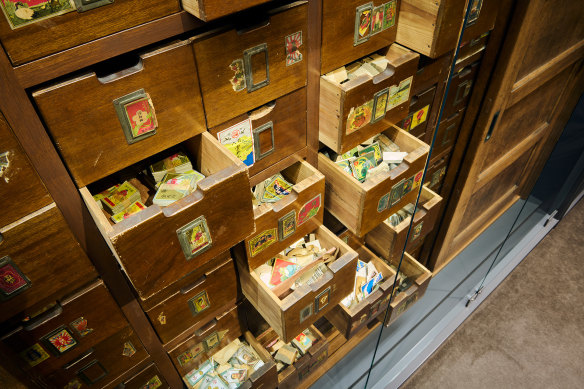
An authentic storage cabinet full of old card pack labels, which used to reside at Nintendo headquarters.
Miyamoto on the museum
Nintendo is a company that doesn’t like to talk about itself. It’s been creating electronic games for 50 years and has innovated a huge amount of the controls and designs we see throughout current video games, yet its products and characters have always been much larger than the company as a brand.
But the landscape is shifting. Nintendo’s rivals in the video game space are no longer fellow toy makers and creators but tech giants. It’s created some of the most recognisable characters of our times and currently has the best-selling video game system on the market, the Nintendo Switch, but its fans don’t know where it came from. If Nintendo considers itself an entertainment company first and foremost, and sees tremendous value in its traditions of modestly creating outrageously original concepts, it may have to start saying that a bit more loudly to create a point of difference.
This museum is a great opportunity for both our employees as well as the fans, to reconfirm what kind of company Nintendo is.
Shigeru Miyamoto
At a media preview of the Nintendo Museum, Shigeru Miyamoto – the 71-year-old artist and director who created characters including Mario and Donkey Kong and who is largely overseeing efforts to push into films, parks and more – said that creating a shrine to itself was very un-Nintendo-like, but that at this point the company was challenging its own views on how it should present itself.
“We’re sort of doing what we’re not supposed to do. And if we’re going to do that, we wanted to make sure that we had something appropriate,” he said through a translator.
“This museum is a great opportunity for our employees as well as the fans to reconfirm what kind of company Nintendo is. It’s really our unique endeavour, the originality that Nintendo creates, that sets the course for the next generation. And to be able to see that through the flow of history was something that we wanted to accomplish with this museum.”
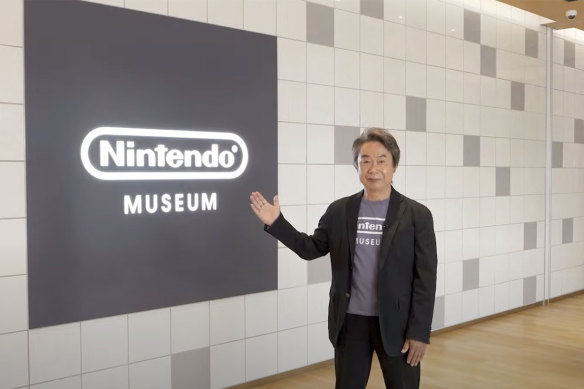
Shigeru Miyamoto has long been one of Nintendo’s top designers and creative directors.
Miyamoto went on to say that he was looking forward to not having to give his yearly two-hour speech to new employees laying out Nintendo’s philosophy because they could just come to the museum instead. And while there’s clearly an element of humour there, it is a huge deal that more than 135 years of history are on display whereas much of it is usually kept hidden.
On the upper floor, I spotted unreleased prototype versions of devices like the Wii Remote and Balance Board, as well as the Nintendo DS and Super Nintendo, all devices that would become huge successes but with development histories kept mostly secret. There is also a section devoted to the Virtual Boy headset, a 1995 commercial disaster that Nintendo hardly ever acknowledges, complete with an emulated version visitors can look into and experience. There’s a huge set of wooden drawers filled with art stickers Nintendo used to place on packs of cards a century ago, an easy-to-fold baby pram that was recalled after it was found to be a bit too easy to fold, and internet-capable game cartridges from the ’80s that Japanese businessmen could use to bet on horses and check stock prices.
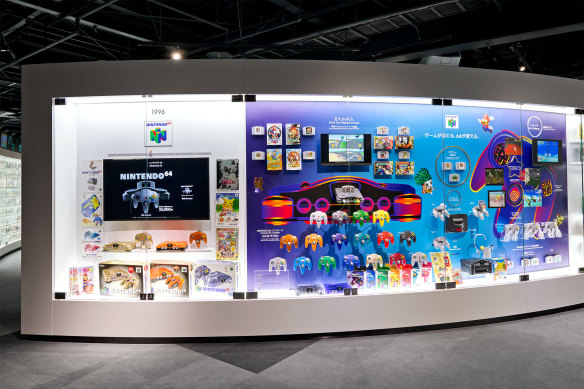
The displays on the upper floor hold thousands of games, controllers, manuals, accessories and prototypes.
Almost all the exhibits, even the most esoteric ones, are presented without commentary or explanation, although there is a section for each game system showing its major original features and the characters that began life there. Miyamoto said that when trialling new games for test audiences, he never talks to or guides the players because he wants to be sure that everything needed for a great experience is in the games themselves. He feels the same way about guiding them at the museum.
“I feel like the only way to communicate to the consumer is through the product. When fans get really excited about Nintendo’s next product [due to advertisements and media], it kind of gets me worried. You should pick it up and experience it first,” he said.
“So I’m hoping what visitors to the museum will be able to do is come when they would like, be able to experience and feel the museum as they would like, and go home with the conclusion that Nintendo is unique. Rather than us having to say, ‘Look, Nintendo is unique!’”
From cards to consoles
The Nintendo Museum is not far from the company’s global headquarters, and just as Nintendo often re-energises old ideas in new forms, this is not actually a new facility; it was originally a card manufacturing plant built in 1969, which was then used to test game cartridges, and then for customer service.
Much of the exterior and lobby area is packed with the familiar aural and visual cues of recent Nintendo, with warp pipes and Zelda music everywhere. But a significant chunk of the experience is about the Nintendo before video games. Visitors can learn about the making of Hanafuda cards – the traditional floral-themed kind that started Nintendo’s business – by doing it themselves, and they can keep the cards they print and glue together. Down the hall, they can even play the game for themselves in a dedicated space. The room furnishings and play areas are very traditional, but a sophisticated roof-mounted projector and camera vision system watches you play and instructs you where to put the cards while also keeping score.
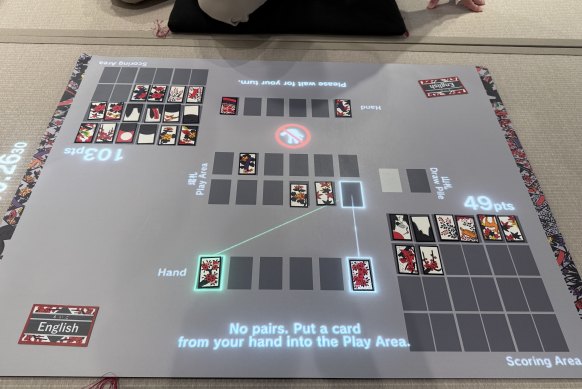
Hanafuda is difficult to grasp, unless a computer is helping you play.Credit: Tim Biggs
The entry to the museum proper leads to the upper floor, where this theme of new technology celebrating old continues. The massive space contains displays of every Nintendo video game system, complete with collections of consoles, accessories, games and controllers from all regions. The sheer number of devices and packages is overwhelming, considering, at this point, a family of three generations could walk in, and each find childhood memories. Monitors showing various games form a circle all the way around an inner track, but thanks to specially developed speakers, you can only hear the sound from each one when you’re directly below it.
Around the outer ring are displays that more broadly group Nintendo’s products into themes. It’s here that you see the true scope of its entertainment creations, from incredible collections of ancient cards to well-preserved plastic playthings of the 1950s and ahead-of-their-time innovations like 1970s light guns and sophisticated office copying machines.
You also get a sense of why Nintendo can afford to go its own way, and might not need to follow the wider industry to a subscription, streaming, games-as-a-service model.
Of course, it’s once you get to the 1980s that you start seeing things that recognisably would become video games, but armed with knowledge about the company’s prior history of rapid-fire original ideas, you get more of a sense of how it arrived in that era so well-prepared. And as you look at the character-specific displays and a long line of monitors showing the evolution over time of major Nintendo game franchises, you also get a sense of why Nintendo can afford to go its own way and might not need to follow the wider industry to a subscription, streaming, games-as-a-service model.
Nintendo is expanding, but not in the same way as the tech giants. It’s moving its established brands and expertise wider while also continuing to innovate in new spaces. It’s creating brand new game characters and series all the time for the next generation of players, but also turning Mario into a movie star and building theme parks. Fifty years from now, there’s absolutely no telling what kind of items this museum might hold.
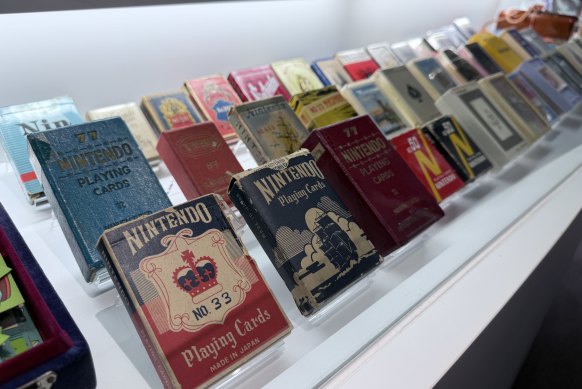
A display of Nintendo card designs from the middle of last century.Credit: Tim Biggs
“Maybe if we end up doing 10 movies, we can open a theatre next door,” Miyamoto said.
“What I do hope is, as Nintendo, we can continue to create something that has a through line across the flow of history, [from our beginnings] to whatever product we’re working on at the time.
A hands-on museum
The upstairs is packed with cool new technology, but the lower floor is essentially a massive experiential game unto itself, bringing games, toys and software from the past to life with brand-new designs.
“When you think about a museum, things don’t move, you can’t touch it, sometimes they can’t move because they’re so old. And I think, where’s the value in that?” Miyamoto said of the decision to create interactive exhibits.
“The idea we had was to not provide the same video game experience, but a different video game experience. At Nintendo, there are a lot of skilled people who have various interests that go beyond video games. So the team that was involved in creating this was almost like a team of volunteers, who were interested in engaging in the creation of it.”
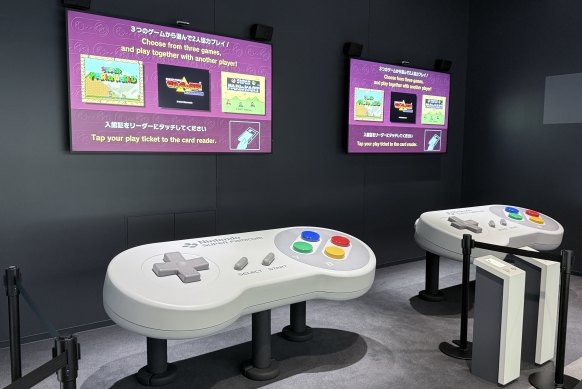
One of the interactive exhibits has pairs of players sharing a giant controller.Credit: Tim Biggs
When entering the exhibition hall, the first thing you’ll see is a massive interactive video floor in the centre, which makes up an exhibit called Shigureden. This is based on a traditional Japanese card game inspired by the 13th-century Hyakunin Isshu poems, which assigned one poem to each of 100 characters. These cards have strong ties to both Kyoto and Nintendo, but here, they’re used in an augmented reality game. Visitors use smartphones to find specific cards as they appear on the floor among the water, leaves and koi fish, with the music and visuals of the exhibition all linked with each device so you can see, for example, when someone else has found their target.
Next, visitors can test their skills with refined replicas of the Ultra Hand, an extendible grabbing toy designed by Nintendo’s Gunpei Yokoi in 1966. I found managing the timing and distance of the grabbing quite difficult as I fumbled to snatch poké balls whizzing by, but nearby, a Japanese gentleman was absolutely clearing them out, and I suspect he may have been tapping into childhood muscle memory.
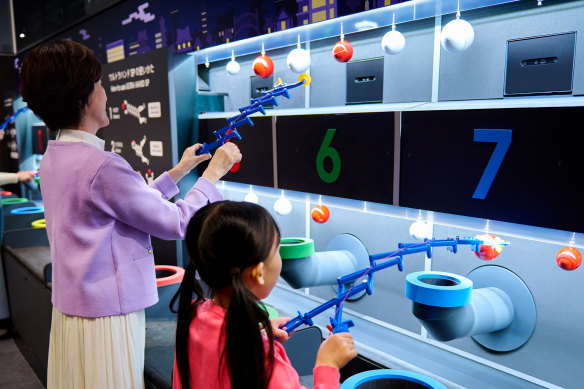
Catching poke balls with the Ultra Hand is not as easy as it looks.
Nearby, a series of batting cages each house a replica of the Ultra Machine, an automatic pitching device sold from 1968. In what may be a cheeky nod to how the machines were actually used (rather than how their users’ parents may have preferred them to be used), each cage is laid out like a Japanese kitchen, bedroom or living room from the ’60s, complete with furniture and objects that react if you whack a ball into them. It’s surprisingly satisfying to launch a ball into a lamp and have it light up.
Throughout the exhibits are recreations of several Game & Watch games (early electronic handhelds inspired by LCD calculators) projected onto the walls, with roof-mounted sensors that capture movement, so visitors can play by moving their shadows around, for example holding their hands up to support the pedestrians in Manhole.
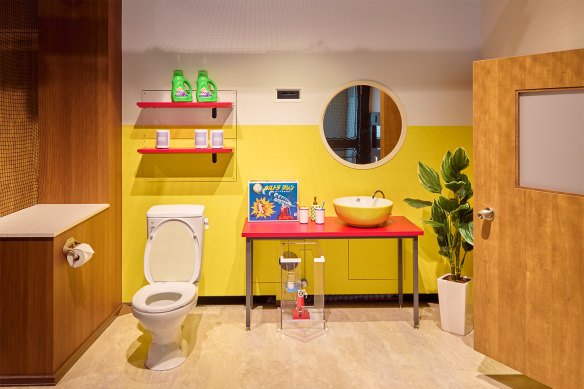
One of the several 1960s rooms you can swing a bat in. Note the Ultra Machine under the table.
A large room laid out like a firing range features a massive video wall. Each patron can choose a replica of either the NES Zapper or SNES Super Scope, light guns designed for home console use in the 1980s and ’90s. The setup also evokes Nintendo’s Laser Clay Shooting System of the 1970s, which was installed in abandoned bowling alleys. In this case, players are not shooting at primitive projections but colourful and animated representations of Super Mario enemies.
Then there’s a take on Nintendo’s 1969 Love Tester, an electronic version of the classic arcade fixture that gives an estimate of a couple’s compatibility. The original is one of a handful of Nintendo products seen in the museum that would potentially be viewed as less than tasteful if produced today (another is a wild toy called Hip Flip that joins partners by the middle and asks them to gyrate to spin a bell), and the new version is still pretty awkward. Players hold hands while each holding a tester, and need to move around together to complete on-screen tasks like cleaning windows and avoiding deadly spikes. At least the scores here might be based on an ability to co-operate rather than whatever the original was measuring.
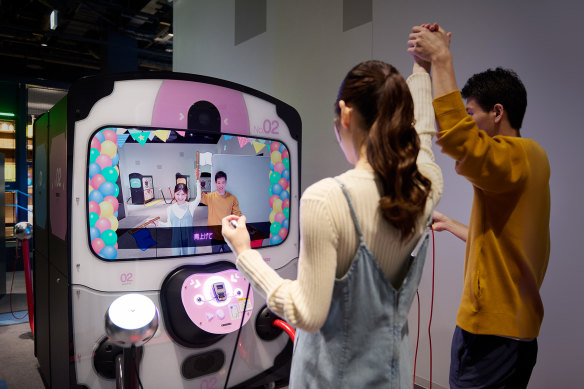
The original Love Tester purportedly measured heart rates, so you could get a better rating by making each other excited. This one at least gives you some harmless physical activity instead.
Finally, there are two rooms where you can pay some coins to play Nintendo games. But, obviously, there’s a twist; in one of the rooms, the controllers are enormous. For these games, two players need to work together to operate the controllers, splitting between the d-pad and buttons on a Super Nintendo, hefting a giant Wii remote, or jumping around on a big Balance Board.
The big caveat to the whole downstairs area is that you’ll have to pick and choose which experiences to have. Customers are not asked to leave the Nintendo Museum after having been there for a certain amount of time, but they are each given a limited supply of 10 virtual coins (stored on their ticket) to spend on the interactive exhibits. So, for example, to play on the big controllers, each of the two players spends two coins for one play. If you didn’t repeat anything, you could play most (but not all) of the different exhibitions with 10 coins, and there’s no way to pay Nintendo for more. You have to come back another time.
It’s perhaps not the way any other museum would do it. But then, if it were, it wouldn’t be Nintendo’s way.
The author travelled to Kyoto as a guest of Nintendo.
Get news and reviews on technology, gadgets and gaming in our Technology newsletter every Friday. Sign up here.